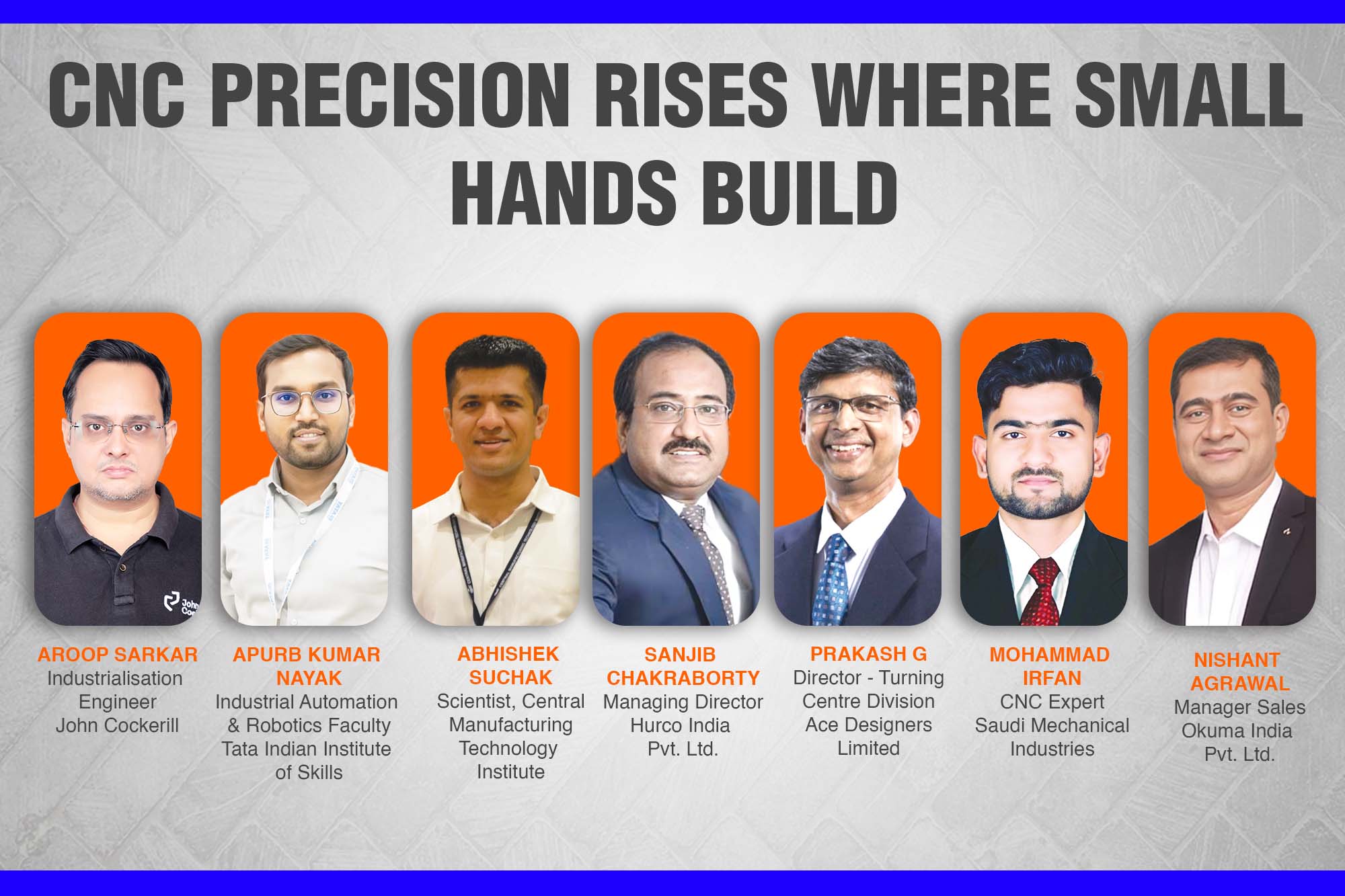Welcome AI-driven robots to your plant
By OEM Update Editorial November 30, 2023 12:50 pm IST
Manufacturing technology is ushering in an era where automation and robotics are redefining the essence of productivity and innovation. From the manufacturing facilities to the intricate logistics and supply chain management, the fusion of human intelligence with technological expertise creates the narrative of efficiency and innovation. Yet, this surge of innovation has its challenges.
The convergence of artificial intelligence, machine learning, the industrial Internet of things, and robotics has become the basis of a paradigm shift. Autonomous robots, driven by AI algorithms, navigate complex environments with remarkable adaptability, precision, and safety. These AI-driven machines are streamlining operations, thus redefining the boundaries of possibilities. Companies embracing this shift experience cost savings through minimised errors and increased operational speed. Ethical considerations surrounding AI and robotics, particularly in decision-making processes, necessitate careful deliberation and regulatory frameworks.
AI-driven robots
Artificial intelligence is significantly shaping the development of autonomous robots, revolutionising their capabilities across industries. Professionals like Upendra Vanarase from TRIO Motion Technology India emphasise how AI algorithms enable real-time decision-making, enhancing efficiency and adaptability. Integrating AI with robotics improves safety and operations in complex environments, especially in factory logistics and warehousing areas.
According to Bharanidharan S. of Addverb, AI-driven robots with integrated sensors perceive and interpret their surroundings autonomously, making informed decisions. These robots continuously improve through machine learning, showcasing adaptability in diverse settings. Their precision and efficiency reduce errors and accidents while boosting scalability and productivity. Extending his viewpoint, Amol Bari from Pilz India emphasises the synergy between AI, automation, safety, and robotics, driving innovation and creating intelligent machines across industries. Advanced AI algorithms empower robots to comprehend their environment, make decisions, and adapt to changing situations, enhancing their autonomy and problem-solving abilities.
Sameer Gandhi of OMRON Automation India highlights how AI algorithms like computer vision empower robots with real-time perception and decision-making abilities. These robots learn from experiences and data, performing tasks more swiftly and accurately than humans. Safety remains a priority as they navigate complex environments, avoiding obstacles and responding promptly to potential hazards. Moreover, AI facilitates seamless interaction between humans and robots, enabling collaboration in shared workspaces. Collaborative robots (cobots) exemplify this by working alongside humans, enhancing productivity and worker satisfaction, particularly in repetitive tasks.
Rajesh Nath from VDMA underlines how AI empowers autonomous robots to adapt, make real-time decisions, and learn from experience, contributing to increased operational efficiency and safety in manufacturing processes. Integrating AI and autonomous robots streamlines operations elevates productivity, and advances manufacturing technologies.
AI charging development of autonomous robots
Automation has become essential in the logistics and supply chain domain, particularly with integrating robotic warehouse systems for inventory management and order fulfilment. Advancements like drones and autonomous vehicles create last-mile delivery, ensure quicker and more reliable transportation, and reduce environmental impact through optimised routes and decreased fuel consumption.
Sensors are vital components enhancing production and logistics efficiency, collecting real-time data on various processes. Sameer Gandhi highlights how sensors help identify bottlenecks, optimise workflows, ensure quality control, automate material handling, monitor worker safety, and optimise energy usage. Particularly, AI-driven autonomous robots and sensor technology are transforming industries, enhancing productivity, ensuring quality, and promoting safety across various operational aspects.
Sensors significantly optimise both production and logistics systems. Rajesh Nath says sensors offer real-time data on factors like position, speed, and environmental conditions, enabling precise control and monitoring. This heightened awareness results in smoother operations, decreased downtime, and efficient resource utilisation. Essentially, sensors contribute to an intelligent manufacturing environment capable of meeting the demands of a fast-paced industry landscape.
Rajesh also emphasised the transformative impact of integrating sensors with the 5G network, revolutionising real-time asset monitoring in manufacturing facilities. This synergy facilitates rapid data transmission, low-latency communication, and seamless connectivity, allowing swift responses to potential issues. Real-time monitoring through 5G-connected sensors enhances predictive maintenance capabilities, reduces downtime, and ensures optimal performance of factory machinery. This integration significantly enhances operational efficiency, positioning manufacturing facilities at the forefront of the Industry 4.0 revolution.
5G, designed specifically for industrial applications, is a crucial element in the communication infrastructure of smart manufacturing facilities. It has notably faster data transmission speeds and reduced latency compared to earlier wireless network generations. 5 G enables instant sharing and reception of sensor data, real-time monitoring, and swift responses.
AMRs and AGVs advantages for manufacturing
As highlighted by Amol, AMRs and AGVs are becoming increasingly indispensable in modern manufacturing and are poised for significant growth shortly. Safety measures compliant with ISO 3691-4 standards are crucial for humans and AGVs to ensure safe operations. However, Bharanidharan underscores the transformative role of Automated Guided Vehicles (AGVs) and Autonomous Mobile Robots (AMRs) in reshaping logistics and manufacturing operations. AMRs, celebrated for their adaptability and flexibility, thrive in dynamic environments without relying on fixed infrastructure. Their scalability and user-friendly nature make them well-suited for businesses with evolving needs. Additionally, AMRs enhance safety and productivity when working alongside humans, offering real-time tracking and data insights for optimisation.
AGVs, on the other hand, excel in controlled environments with defined pathways. They ensure precise and reliable movements, making them ideal for repetitive tasks and handling substantial loads, particularly in manufacturing sectors. While AGVs follow fixed paths, AMRs utilise natural feature navigation guidance and operate autonomously, as Sameer explained. This distinction offers AMRs significant advantages in efficiency, flexibility, safety, scalability, error reduction, cost savings, and integration with emerging technologies. This elevates workflows, productivity, and competitiveness in dynamic business landscapes.
AMRs specialise in automating material handling and transportation tasks, reducing manual labour, optimising space usage, and enhancing operational efficiency by minimising idle time. Their adaptability allows quick adjustments to changing production or logistics needs without major disruptions, offering scalable deployment for efficient resource allocation and cost-effective operations.
These robots, equipped with advanced safety features like sensors and collision-avoidance algorithms, ensure workplace safety by detecting obstacles, reducing accidents, and providing managers with visibility into robot location and performance for informed decision-making. Integration with Industry 4.0 technologies like IoT and data analytics drives data-driven decision-making, predictive maintenance, and process optimisation, fostering connectivity and establishing intelligent ecosystems within automated systems.
AMRs and AGVs transform manufacturing and logistics, enhancing flexibility, efficiency, and safety. At the same time, they automate tasks and contribute to cost savings, accuracy, and responsiveness in contemporary operational landscapes.Enhancing operations
Automation has expanded beyond the shop floor, extending into IT connectivity, cloud services, and integration within supply chains and logistics. Amol highlights the growing implementation of automated guided vehicles (AGVs) and autonomous mobile robots (AMRs) in manufacturing logistics and warehousing. However, ensuring uninterrupted operations remains critical for efficient processes in these environments. Amol emphasises the importance of OEMs seeking comprehensive solutions encompassing sensors, controls, safety, and security from a single provider to enhance performance and leverage maximum benefits.
Securing these systems against unauthorised access is paramount for factory security. Adherence to safety standards like ISO 3691-4 and obtaining CE approvals for AGVs and AMRs remains imperative. AMRs, utilising advanced sensors and AI algorithms, enhance the intelligence of AGVs, thereby boosting their efficiency and overall performance. These robots find widespread applications in logistics and warehouses, replacing manual handling with autonomous operations, reducing safety risks, improving workplace conditions, and streamlining factory floor operations.
As highlighted by Upendra, the evolution of manufacturing facilities into future-ready entities heavily relies on the integration of collaborative robots (cobots). These cobots, designed to work alongside human operators, bring about a significant shift in quality improvement. By merging human dexterity with robotic precision, cobots elevate overall product quality, minimise errors, and optimise assembly line processes. This integration results in a more adaptable, efficient, and flexible manufacturing ecosystem that meets ever-evolving market demands.
IIoT revolution and sustainable future
The Industrial Internet of Things is a pivotal automation system revolutionising future factories and enhancing product quality. Its integration brings forth a range of advancements in quality control and overall factory operations through real-time monitoring, predictive maintenance, inspections, and data-driven decision-making. Sameer Gandhi highlights that leveraging IIoT capabilities allows factories to achieve heightened automation, superior quality control, increased efficiency, reduced costs, and improved customer satisfaction, ultimately resulting in upgraded operations that deliver high-quality products.
There is active support from governments and industry groups for OEMs and factories adopting technology, offering financial incentives, research funding, and policy structures. This promotes eco-friendly innovations like 3D printing, advanced robotics, and smart automation. Upendra underscores industry associations’ collaboration with manufacturers to establish and promote optimal practices, fostering a sustainability-focused ethos. These technological advancements drive production efficiency, reduce waste, lower energy consumption, and minimise carbon emissions, carving the way for a more sustainable and resilient future in manufacturing.
In conclusion, the rise of automation and robotics heralds a future where technology and human expertise coalesce for productivity and sustainability. From transforming production lines to redefining the essence of logistics, this evolution navigates the delicate balance between innovation and responsibility.
As industries embrace AI-powered robotics change, the key lies in integrating technology and human ingenuity. This sheds light on a future promising efficiency and a sustainable tomorrow by enhancing innovation, precision, and productivity.
Rajesh Nath, Managing Director, VDMA.
“By automating material handling and transportation tasks, AMRs and AGVs reduce labour costs and improve accuracy, resulting in a responsive operational environment.”
Sameer Gandhi is the managing director of OMRON Automation India.
“AMRs integrate with Industry 4.0 technologies like IIoT and data analytics. This integration drives data-driven decision-making, predictive maintenance, and process optimisation.”
Amol Bari, Head – Services Business, Pilz India Pvt. Ltd.
“Integration of AI enriches autonomous robots with improved sensory capabilities, learning abilities, and problem-solving skills, contributing to their autonomy and effectiveness.”
Upendra Vanarase, Managing Director, TRIO Motion Technology India Pvt. Ltd.
“Adopting motion-first concepts in manufacturing facilitates smooth data interchange and the integration of AI and ML algorithms for complex motion-related tasks.”
Bharanidharan S., Chief Business Intelligence Officer, Addverb
“Autonomous robots powered by AI excel in tasks requiring precision and efficiency, significantly reducing the likelihood of errors and accidents.”
Ajay Gurjar, Director & COO, Yaskawa India Pvt. Ltd.
“AI integration contributes to predictive maintenance, minimising downtime by anticipating and addressing potential issues proactively, thus optimising overall productivity.”
Cookie Consent
We use cookies to personalize your experience. By continuing to visit this website you agree to our Terms & Conditions, Privacy Policy and Cookie Policy.















